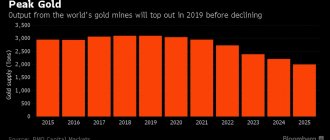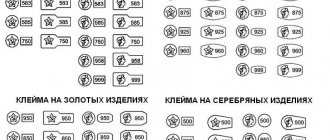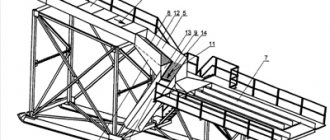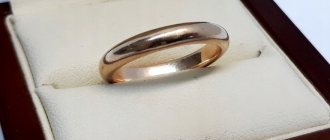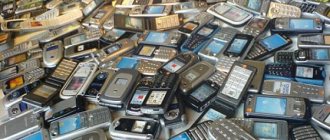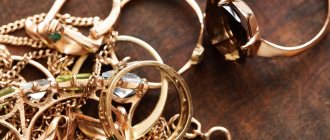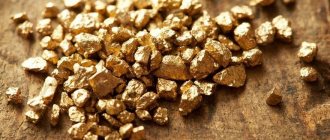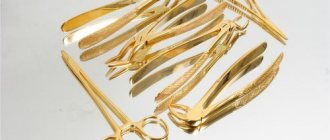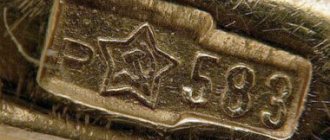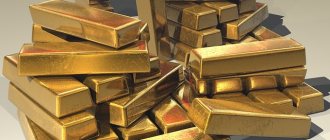26.02.2021
In order to reliably preserve and increase existing savings, people have always invested money in gold. The return on investment in the yellow metal is growing every year. However, in percentage terms it is inferior to silver due to the high price of gold assets. In his article, Doctor of Physics and Mathematics Vladimir Mitroshin analyzes the dynamics of the price of gold and the prospects for investment in the precious metal.
At the beginning of the summer of 2019, the price of gold began to rise steadily around the world. You can determine how much it was in one or another of the past months using the following formula:
[price] = 1240 +39.5*x
volatility corridor =2.6%
x=1 (month number from June 2019),
multiplying the serial number of the month (we will assign the value “1” to June 2019) by 39.5 and adding 1240 to the resulting value. In this case, the volatility corridor will be 2.6%. Changes in supply and demand may cause the current value to differ from the estimated price.
However, for 1.5 years now, this pattern has remained unshakable due to the annual demand for the precious metal at a level of about 4,300 tons. You can study the growth dynamics in more detail and evaluate the profitability of investments in gold using the given graph.
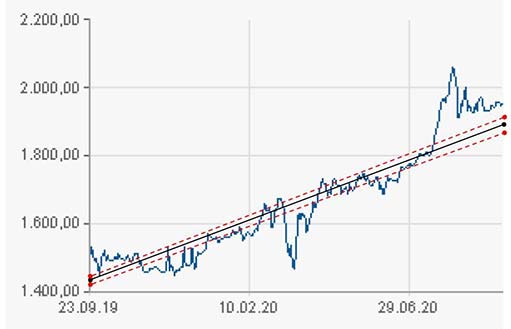
The straight line here corresponds to the calculated data obtained using the above formula. Two red dotted lines mark the volatility corridor.
The rise in the price of gold above the psychological level of $2,000 per ounce is explained by expectations of a stock market crash.
The first discrepancy between market dynamics and this pattern appeared at the end of autumn 2020, when reporting for the third quarter showed a 30% decrease in demand for jewelry.
If we take into account that the jewelry market provides 43% of the total global demand for gold, then the decrease in the cost of the precious metal was 12.9% compared to the calculated value. The situation with jewelry improved a little during the New Year and Christmas holidays. But this was a short-term improvement.
It is difficult to calculate further changes in the price of gold. It is possible to estimate only the minimum value. We obtain it by multiplying the estimated price by the difference 1 – 0.129 = 0.871. Thus, February 2021 has a serial number of 21. To calculate the lower price threshold, for example, on the 9th day of the month, we add to 21 the ratio 9/27 = 0.333. The formula for further calculation is as follows: 1240 + 39.5 x 21.333 = 2082.7. Then: 2081.2 x 0.871 = 1814.0 +/- 23.6.
The spot market price of gold that day was $1,839.2 per ounce. As you can see, the calculation paid off. In this case, the cost could be slightly higher, but not lower than the calculated value.
The high return on investment in gold and the upward trend can be partly explained by the fact that the available volume of its reserves in the bowels of the planet does not exceed 50,000 tons. That is, with the current level of precious metal consumption of more than 4,000 tons per year, it will last only 12 years. Since awareness of this has not yet occurred on a large scale, the curve for the increase in the price of gold still has linear characteristics.
Next, we will analyze the reports of the World Gold Council for the past year and try to predict the profitability of investments in gold for 2021.
Return on investment in gold in 2021
The decrease in demand for precious metal in the jewelry market due to the coronavirus pandemic amounted to 34% and reached a minimum of 1,410 tons. Despite the pre-New Year's excitement, this sector of the market has not recovered from the consequences of the coronavirus crisis.
In the industrial sector, demand for gold decreased by 10.4% and amounted to only 284.5 tons.
Central Banks of leading countries reduced purchases of precious metals by 59% and purchased no more than 272.9 tons during the year. The leader in this list is the Turkish Central Bank, which bought 134.5 tons of gold and increased its gold reserves to 547 tons.
The global drop in demand for gold last year was 14% and reached 3,760 tons. The last time such a minimum was recorded was in 2009.
On the other hand, thanks to the high return on investment in gold through ETFs, the influx of precious metal into these structures reached 877.1 tons or $47.9 billion in monetary terms. But this did not lead to compensation for losses from decreased demand in other market sectors.
The year 2020 showed an increase in interest in investing in gold in the form of gold coins and bars from private investors. In Turkey alone, this component of demand doubled and amounted to 121 tons.
In European countries, private investment in gold increased by 67% and reached 256.2 tons. Germany leads in terms of sales of gold coins and bars, reaching 163.4 tons. Residents of the European Union were forced to transfer cash into gold by record low key interest rates, which wiped out the profitability of bank deposits and increased the popularity of alternative protective assets.
In the United States of America, 66.4 tons of gold were purchased over the past year in the form of gold coins, as well as precious metal bars. This is triple the volumes of 2021 and is explained by the decline in the popularity of the dollar in anticipation of the looming financial crisis.
Chinese private investors purchased 9% more gold coins and bars than in 2019. The sales volume of these assets in China amounted to 246.59 tons. Indians, on the contrary, lost interest in gold and bought only 130.4 tons of the yellow metal, showing a historical low. This difference in demand between neighboring countries can be explained by the effective fight against the pandemic in China and the severe coronavirus situation in India.
If we talk only about the global investment demand for gold, then last year, against all odds, it grew by 40% and amounted to 1,773.2 tons.
Chubais was accused of involvement in the theft of 3 tons of gold
The guest of the new episode of the “Legend” program on the RTVI channel was Hero of the Soviet Union, retired aviation major general, former vice president of the Russian Federation (1991-93), former acting. O. President of the Russian Federation (09.22-04.10.1993) and ex-governor of the Kursk region (1996-2000) Alexander Rutskoy .

In particular, Rutskoi spoke about his activities as head of the Interdepartmental Commission of the Security Council for the Fight against Crime and Corruption, about the famous eleven suitcases of compromising evidence on Yeltsin’s largest officials, about the plunder of the country by temporary democrats.
“They robbed with such admiration, with such delight and with such impunity that it had to be stopped,” stated Alexander Vladimirovich. His attempts in this direction were harshly suppressed. Although, according to Rutsky, many famous personalities deserved to be shot. Let us recall that the report of the Interdepartmental Commission of the Security Council on Combating Crime and Corruption featured such characters as the late Yegor Gaidar, healthy and feeling great (in the position of Special Representative of the President for Relations with International Organizations to Achieve Sustainable Development Goals) Anatoly Chubais, ex -Secretary of State Gennady Burbulis (at the end of the 2000s he founded his own sect called the School of Political Sophy “Dignity” and travels around giving lectures, promoting “new spiritual practice”), then-Deputy Prime Ministers Alexander Shokhin (now the president of the Russian Union of Industrialists and Entrepreneurs, president of the National Research University " Higher School of Economics", a member of the Bureau of the Supreme Council of the United Russia party) and Vladimir Shumeiko (quietly resting in retirement, being a co-chairman of the board of trustees of the Moscow English Club), the then Minister of Foreign Affairs Andrei Kozyrev (in 2012 he left for Miami, where under In defense of the CIA, the collective West is calling on the collective West to “resist Putin”) and Press Minister Mikhail Poltoranin (a Yeltsinist with experience in the 21st century has retrained himself as a patriot, an exposer of former comrades and the world behind the scenes).
A characteristic moment from Rutskoi’s memoirs: “Gold is being loaded into a Swiss bank as collateral for a loan. They load 10 tons - here it is, an invoice, a receipt, everything is as it should be - and 7 arrives. Shrinkage, shrinkage (you know, trucks carry food products and so on, there is shrinkage) ... How could three tons of gold be dried? And here is the first scandal with the president. I come to him and report. And so he tells me: “Alexander Vladimirovich, I’ll sort it out. Well, don’t take it emotionally.” I say: “Boris Nikolaevich, we are not so rich today as to allow three tons to disappear.” I left him, but forgot my glasses, I got up, and the door to the office was ajar. Gaidar, Burbulis, Chubais are standing there . And so he lectures them there about the wrongness of sending gold.”
Things of days gone by, a dark forest for the young. But there are still a lot of interesting things in the interview. See for yourself:
“Sooooo. Rutskoi woke up and immediately killed Chubais for 3 tons of gold. On the other hand, who else can launch an attack? We’ll see what the Prosecutor General’s Office says, since this is a public statement about a crime,” said political scientist Marat Bashirov.
Subscribe to our channel in Yandex.Zen!
Click “Subscribe to channel” to read “Tomorrow” in the Yandex feed
Fifteen tons of gold hidden in southern Russia
Historians, archaeologists and lovers of antiquity have been dreaming for many decades of finding the legendary treasure - golden horses, once cast on the orders of Batu Khan. The one who finds them will not only be able to end his days in limitless luxury. The cost of the precious artifact is such that, as if in the film “Shirley Myrli,” the whole country will be able to vacation in the Canaries for three years. But where to look for the treasure? And does it really exist?
On the chilly March of 1242, Khan Batu, swinging in the saddle of an argamak embroidered with gold brocade, returned to the Great Steppe. The grandson of the shaker of the Universe, Genghis Khan, was pleased: the western campaign was definitely a success. Left behind were the devastated Russian principalities, squeezed by the Mongol lasso; the strength of his tumens was recognized by Poland, the Czech Republic and Hungary, whose knights clad in steel armor could not do anything with the nimble warriors on steppe horses. Now the path of the army and Batu himself lay to the east, where he was to camp near the mouth of Itil. For the Mongols, accustomed to constant nomadism, it was not difficult to spend several months in an open field: portable felt yurts reliably protected from rain and sun, sheltering not only people, but also livestock in case of bad weather. But Batu, who had tasted all the delights of European life, no longer wanted to huddle in a tent. The luxury of the palaces of Krakow and Pest captured the imagination of the steppe ruler. Now he wanted to benefit from the achievements of civilization himself.
Build a city? The will of the khan, as is known, is the law. Woe to him who goes against her!
Steppe Barn
Batu Khan ordered the founding of his city, which was destined to soon become the capital of the Great Horde, on the banks of the Akhtuba, the left tributary of the Volga. Perhaps, in the whole world at that time there was not a single ruler who had the power to give such an order. But was it in vain that the ferocious Mongol army crossed half of Europe with fire and sword, subjugating dozens of nations? By order of Batu, caravans pulled from all the conquered lands to the Volga. Thousands of horses and camels carried colored glass, luxurious carpets and elegant furniture to the future city. And most importantly - masters chained in chains: masons and architects. Long gone are the days when, having taken another city, the Mongols slaughtered every last one of its inhabitants. The cunning Chinese, whose capital fell under the blows of battering rams, taught their new masters: it was better for the conquered peoples to pay tribute, because you can’t take much from the dead. And at the same time they strengthen the greatness and power of the Horde with their skills and talents.
Stone cutters and jewelers were brought from Kyiv, Vladimir with tears gave his best carpenters to the steppe people, and the Chinese sent engineers and architects. The new city, which arose from scratch in just a couple of years, received the name Sarai-Batu - Batu Palace. Archaeologists have already established: in the middle of the 13th century there was no city in the world larger and more comfortable than the Mongol capital. Its population was 75 thousand people, while even Paris had only about 70 thousand. In addition, the subjects of the French king took water from the Seine, and poured sewage from the windows of the houses directly onto the street, which is why the dirt on them was so bad that they had to walk on stilts. In the steppe Sarai there was not only water supply, but also sewerage! And inside Mongolian houses there was a heating system - a pipeline through which warm air was supplied from the stove.
On the highest hill above the bank of Akhtuba stood the Khan's palace. “At the upper, northern end of the island, on a rocky hill, a small toy house with a light lace turret, all lined with colored tiles, shimmered with joyful bright colors of a strange, unusual appearance,” wrote Vasily Yan. “Each tile had a design with swirls and a patterned border, and each flower had a thin petal of red gold fused into it. In the bright rays of the morning sun, the whole house sparkled and glowed, as if made of hot coals.”
On this topic
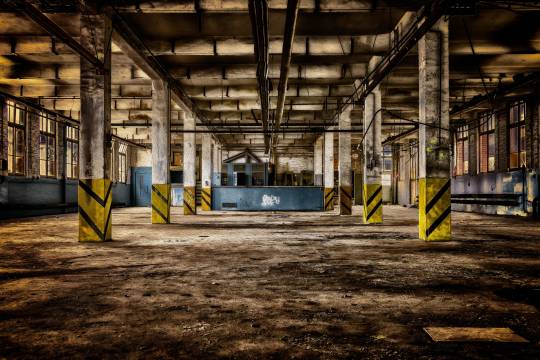
677
Moscow City Duma Deputy Artemyev: Construction of a large technology park in the south of Moscow would be a logical step
Deputy of the Moscow City Duma Oleg Artemyev, in a conversation with journalists, said that the construction of a new large technology park in the south of the capital will create new jobs.
But still, the main decoration of the palace was considered to be two horse statues that stood at the main entrance. According to legend, the ruler of the Mongols ordered that all the tribute collected during the year from the conquered peoples be turned into gold, and that the figures of horses be cast from that gold. Sparkling in the sun, they amazed the imagination of city guests, personifying the power of the Horde state. As legend has it, 15 tons of precious metal were needed to make the statues.
Golden horses delighted the eyes of the Horde khans for almost a century and a half. At the beginning of the 14th century, the statues were transported to the new capital - New Saray, or Saray-Berke, located near the present village of Tsarev near Volgograd. And soon the history of Genghis Khan’s empire began to decline. And when in 1380, after the defeat on the Kulikovo field, the ruler of the Horde Mamai had to urgently reel in his fishing rods, he took the golden horses with him. Since then no one has seen them again.
The dark mounds are sleeping
As to where the legendary “Batu’s horses” may now be, there is a whole set of versions. According to the most common one, one of the statues was buried in the mound along with the body of Mamai, who died in the battle. But it has still not been possible to find the grave of the Mongol commander. Although some historians express the opinion that the legendary Mamayev Kurgan in Volgograd is the last refuge of the Horde temnik, and not at all the place of its forward outpost, as is commonly believed. Indeed, objects related to the Mongol invasion were found on the mound, but there is no more significant evidence for this version. And no one will allow excavations under the “Motherland” in search of a mythical treasure. Moreover, the location of the mound where Mamai is supposedly buried is claimed by the Astrakhan, Volgograd and Rostov regions, as well as the Crimea, where ancient mounds are visible and invisible.
In search of Horde treasures in the mid-19th century, archaeologist Tereshchenko excavated mounds in the New Saray area. It seemed that luck was about to smile on him - in the ground he found jewelry, a golden cup and the crown of Khan Janibek. But no matter how much they dug in the area, no horses could be found.
As for the second statue, a legend that has come down from time immemorial describes its fate. According to it, the horse was stolen by the ancestors of the current Don Cossacks, who already inhabited the Wild Field at the beginning of the 14th century. According to legend, a Cossack detachment made a daring raid on Sarai-Berke when the main forces of the Horde were on a campaign. Making a noise, they broke the statue into pieces, loaded them onto carts and took them to their kurens. Having learned about what had happened, the Horde immediately returned from the march and rushed in pursuit of the brave men. As a result, the Cossacks had no choice but to drown their horse in a nearby river in the hope of later returning and picking up the loot. Alas, this did not happen - all the raid participants died in the battle, taking the secret of the golden horse with them to the grave.
Or maybe they never existed? However, the legend is supported by the chronicles that have reached us. His contemporary, the Flemish monk and envoy of the French king Louis IX, Saint Guillaume de Rubruk, who visited Sarai-Batu, wrote about the golden horses of Khan Batu. “From afar, we saw a sparkle at the gate and decided that a fire had started in the city. As we approached closer, we realized that it was two life-size golden statues of horses shining in the rays of the rising sun. How much gold went into this miracle?” - he asked in his book “Journey to the Eastern Countries.”
The science fiction writer and part-time venerable paleontologist Ivan Efremov wrote about the discovery of a golden horse in the distant future in “The Andromeda Nebula.” It turns out that you believed in the legend?
And although many historians still question the fact that the statues could have survived to this day, and believe that they were not made of cast gold, but at best hollow, every year, going to excavations, dozens of archaeologists hope in their hearts: What if a golden mane sparkles among the black soil under a tassel?
